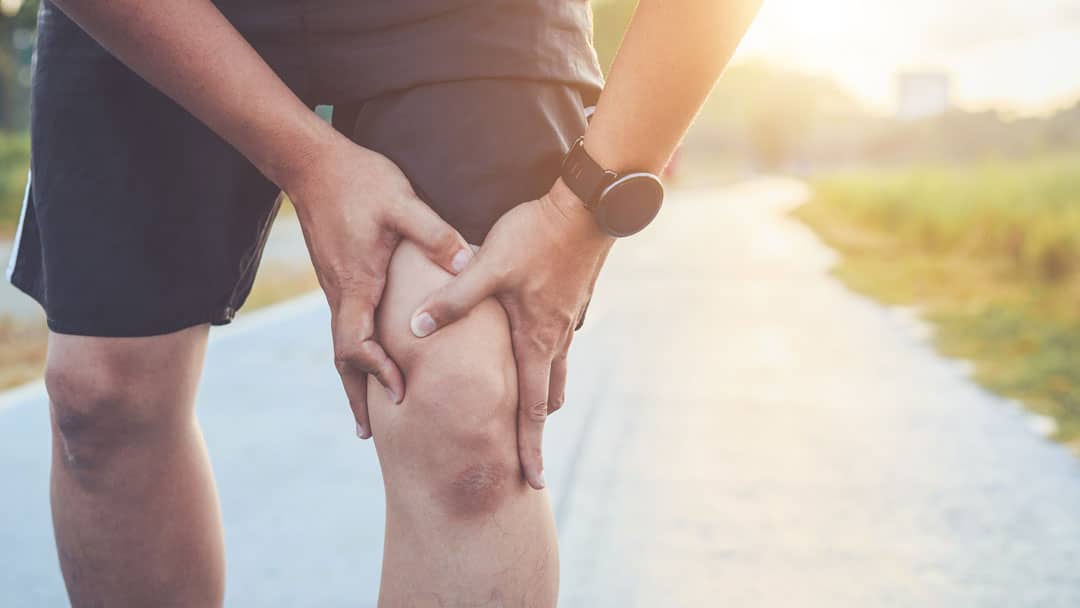Our knees are the body’s largest joint, they’re vital for movement, and they can be vulnerable to injury. Since they carry much of the responsibility to bear our weight, it’s easy to notice when they aren’t bringing their A-game.
While we all want to think our knees will hold out and continue to keep us mobile, the reality is most of us will start to feel our knees fussing at one point or another. That doesn’t mean your exercise days are over, though. You can still hit the gym and keep moving with a bit of planning and prep.
Tips for exercising with knee pain
Warm-up
Warming up before your workout doesn’t just increase your body temperature and loosen muscles; it also preps joints like your knees for the upcoming work. Check out these warm-up tips by Strength and Conditioning Coach Roger Takahashi.
Maintain a healthy weight or BMI
Keeping your weight in check can help to reduce knee pain, making it that much easier to exercise. Check out these healthy eating tips and use this tool to calculate your body mass index (BMI). A healthy range is 18.5 to 24.9, while a BMI of 25.0 or more is considered overweight.
Importantly, and especially if you have injured your knees before, listen to what your doctors and physiotherapists suggest when it comes to building your knees back up. They’ll know your history and work with you to figure out what muscles you need to work on to support your overall knee health.
Keep workouts frequent and short
Instead of overworking your knees in the gym and trying to power through a 1-2 hour workout, stick to shorter and more frequent exercises that don’t put too much strain on your pain points. However, if exercising leads to increased pain, try reducing the intensity or the weight or stop the activity altogether.
Vary your workouts
Cross-training lets all your muscles work at different points and gives others a break when you’re focusing on certain areas per workout! Change up your routines and try different exercises. This will help to prevent overuse injuries and give your knees some time off.
Wear proper shoes
Don’t skimp on proper footwear, and consider replacing them more frequently. With time, your workout sneakers or runners start to lose their support. On average, replace your footwear every 5-6 months if you workout 30 minutes a day or after 500 to 800 km.
Knee exercises for bad knees
Knee pain doesn’t have to sideline you from your workouts. There are lots of great exercises out there that can work to alleviate your knee pain or keep the pain at bay—like these three:
The half-squat
- Stand with your feet shoulder-width apart.
- Bend your legs and push your butt back, extending your arms forward and keeping your neck and upper body in an upright position.
- Stop at a 45-degree angle, and pause for a second.
- Slowly come back to standing.
- Repeat.
Half-squats relax your knees and focus strength-building on those important muscles around your knees—quads, hamstrings and glutes.
Wall sits
- Stand about two feet from a wall, with your back to the wall.
- Lean your upper body against the wall, and have your feet shoulder-width apart.
- Press into the wall and slide down until your thighs are parallel to the floor.
- Ensure your knees are above your ankles, at a right angle.
- Hold your head, shoulders and back against the wall.
- Hold this position for 20-60 seconds.
Wall sits isolate and strengthen your quads, and when your quads are at their best, it alleviates knee pain.
Lateral walk
- Stand with your feet hip-width apart.
- Squat down to a 45-degree angle, push your butt out and keep your back straight.
- Step your right foot out to the side about shoulder-width apart from your left foot.
- Step your left foot in towards your right foot, bringing your two feet back to hip-width apart.
- Repeat this sequence for 10 steps.
- Switch directions, and take 10 steps back with your left foot leading.
Pro tip: If this feels easy, add a resistance band above your knees or around your ankles.
Lateral walking gives your butt and hip muscles a good workout, strengthening your hip flexors and extensors, which all help keep your knees in line.
If you’re in a real battle with your knee pain, low-impact exercises are an easy option to keep you moving. Walking is always an easy option, while swimming and activities like water aerobics are also a great calorie burn and don’t put pressure on your knees.
Cardio that’s easy on the knees
Some people may wonder if cycling or using an elliptical is bad for their knees. In short, both of these activities are relatively low-impact on your joints while building on your range of motion and strengthening muscles.
Pay attention to your form when cycling or working out on the elliptical, and listen to your body! If you’re starting to feel familiar aches in your knees, stop exercising.
Stretches to help alleviate knee pain
The muscles around your knees also need to stay limber to keep your knees feeling their best. Tight knees and leg muscles will only add to the pain you’re experiencing, so be sure to incorporate stretching into your cool-down. Try these stretches:
Hamstring stretch
- Lie down on the floor or a mat.
- Straighten both legs out in front of you, or bend your knees, so your feet are flat on the ground.
- Lift one leg off the floor.
- Place your hand behind that thigh, below the knee.
- Pull your knee towards your chest until you feel a stretch.
- Hold for 30 seconds.
- Switch sides and repeat.
Quad stretch
- Stand next to a chair or wall.
- Keep your feet shoulder-width apart.
- Bend your knee, grab your ankle and pull it towards your butt until you feel a comfortable stretch.
- Hold for 30 seconds.
- Replace your foot on the floor.
- Switch sides and repeat.
Calf stretch
- Stand in front of a wall, with one leg straight behind you and the other beneath you, slightly bent.
- Put your hands on the wall in front of you.
- Keep your back leg straight, with your heel on the floor.
- Hold for 30 to 60 seconds.
- Switch sides and repeat.
What other exercises, tips or tricks help with your knee pain? Let us know in the comments!
Are You at Risk?
Learn your risk level for the most common men’s health conditions in 10 minutes with a free, confidential, and personalized report.


Let’s Talk!
Did you enjoy this article? Let us know in the comments.
0 Comments